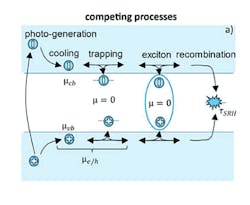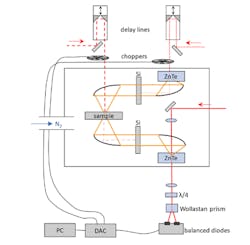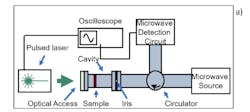Microwave/THz Instrumentation Assesses, Resolves PV-Material Performance Data
What you’ll learn:
- The relationship between RF energy and assessing potential photovoltaic-material performance.
- The two overlapping ways to excite and measure PV materials such as perovskites.
- How the conflicting test results were resolved.
It may seem from a first glance that there’s little in common between the dc performance of solar cells and their constituent photovoltaic (PV) materials and the RF world of microwaves and terahertz (THz) energy. Of course, a close connection exists at the atomic-physics level, as the mobility and lifetime of electrons and holes in the PV material translate into light-induced current flow in PV systems when energized by electromagnetic radiation.
Those two parameters—mobility and lifetime—are among the most important properties of a semiconductor to be used as a solar cell, as large charge-carrier mobilities are desirable to enable efficient charge injection and extraction.
Both parameters can be measured without contacts via spectroscopic methods using terahertz or microwave radiation. However, the resultant measurement data found in literature often differs by orders of magnitude. This has made it difficult to use the results for reliable assessments of material quality.
Higher-Accuracy PV-Material Performance Determination
In recent years, perovskite semiconductors in particular have attracted attention, as they’re relatively inexpensive, easy to process, and enable high efficiencies. Now, researchers at Helmholtz-Zentrum Berlin (HZB) took a major step in more accurately determining the potential performance of PV materials such as perovskites without the need to fabricate solar cells or make physical contact. They combined the expertise of 15 laboratories to quantitatively model and analyze the current-voltage characteristics of a solar cell from such measurements.
Note: If you’re not familiar with HZB, it’s the result of the merger of two research institutions—the Hahn-Meitner-Institut (established in 1959) and BESSY GmbH (1979). With approximately 1,100 employees, it’s one of the largest non-university research centers in Berlin.
TRMC and OPTP
Both charge-carrier mobilities and lifetimes can be probed without physical contact by Time-Resolved Microwave Conductivity (TRMC) and Optical-Pump Terahertz-Probe (OPTP) spectroscopy, making them excellent tools for the characterization of photovoltaic materials (Fig. 1). OPTP can monitor fast processes like trapping into defect states and exciton formation, while TRMC adds the slower processes such as long-living trapped carriers or weak recombination in advanced materials, e.g., halide perovskites.
The contactless nature of the measurement is a major advantage of OPTP and TRMC over more conventional techniques such as dc-conductivity and Hall-effect measurements. That’s because it overcomes interface issues such as contact resistance, unintentional doping, and bandwidth limitation, and it allows for the study of bare films and even powders. However, these measurements of an electrical potential corresponding to solar-cell operating conditions can’t be applied directly due to the lack of those same contacts.
New Measurement Process
Therefore, the OPTP and TRMC measurement conditions must be translated to the specifics of the thin-film device, which results in different interpretations due to subtleties and difference in the models used by the different institutions. To overcome this obstacle, the HZB team worked with the other institutions to develop a consensus on the interpretation of TRMC and OPTP measurements, using a halide perovskite (Cs,FA,MA)Pb(I,Br)3 thin film as a case study.
This measurement process is a complex multistep sequence:
- The first step is to characterize carrier trapping and exciton formation (an exciton is a bound state of an electron and an electron hole, which are attracted to each other by the electrostatic coulomb force) as the corresponding quantum yields are crucial for assigning relevant lifetimes and electron and hole mobilities (Fig. 2).
- Second, material is exposed to continuous “1 sun” illumination while OPTP and TRMC spectroscopy are measured after pulsed excitation.
- Third, OPTP spectroscopy (Fig. 3) or TRMC spectroscopy (Fig. 4) is used to measure the mobilities of charge carriers in electric fields that alternate at THz or GHz frequencies, respectively, which must be translated to the dc-transport through the thin-film solar cells.
- Finally, the precision of the results was determined by an inter-laboratory comparison. Resolving the differences and providing final data with confidence was a primary goal of the project.
Both techniques probe the formation and kinetics of photoexcited electrons, holes, and excitons by measuring photoconductivity transients, as well as mobilities. Pulses from an optical pump induce photogeneration of charge carriers in the (perovskite) sample. Depending on their mobilities, these carriers are accelerated laterally in an electric field of a terahertz probe pulse or by a standing microwave in a cavity, which alternate at terahertz or gigahertz frequencies, respectively.
The photogenerated carriers then acquire an oscillating drift velocity, and thereby a part of the terahertz or microwave radiation is absorbed. The corresponding pump-induced change in the transmitted terahertz electric field (ΔE/E) or in the reflected microwave power (ΔP/P) is measured and analyzed in a first step for the sheet photoconductivity or photoconductance. TRMC and OPTP measurements yield mobilities for charge carriers oscillating at GHz and THz frequencies.
To characterize dc-device performance, the effective mobility relevant for direct transport through the thin-film device must be estimated, which is accomplished by additional data analysis and conversion to determine the desired parameters.
By combining the expertise of 15 laboratories, the HZB work identified error sources. Thus, it provides a “best practice” model for the interpretation measurements on photovoltaic materials to better predict their potential performance in solar cells (Fig. 5).
The work is detailed in their lengthy and intense, yet informative and readable, 16-page paper “Predicting Solar Cell Performance from Terahertz and Microwave Spectroscopy” published in Advanced Energy Materials (with 29 authors from the 15 institutions!). It’s bolstered by a 23-page Supporting Information document.
About the Author

Bill Schweber
Contributing Editor
Bill Schweber is an electronics engineer who has written three textbooks on electronic communications systems, as well as hundreds of technical articles, opinion columns, and product features. In past roles, he worked as a technical website manager for multiple topic-specific sites for EE Times, as well as both the Executive Editor and Analog Editor at EDN.
At Analog Devices Inc., Bill was in marketing communications (public relations). As a result, he has been on both sides of the technical PR function, presenting company products, stories, and messages to the media and also as the recipient of these.
Prior to the MarCom role at Analog, Bill was associate editor of their respected technical journal and worked in their product marketing and applications engineering groups. Before those roles, he was at Instron Corp., doing hands-on analog- and power-circuit design and systems integration for materials-testing machine controls.
Bill has an MSEE (Univ. of Mass) and BSEE (Columbia Univ.), is a Registered Professional Engineer, and holds an Advanced Class amateur radio license. He has also planned, written, and presented online courses on a variety of engineering topics, including MOSFET basics, ADC selection, and driving LEDs.





